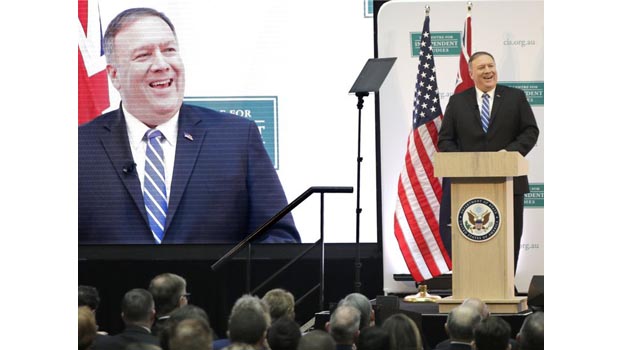Five Eyes’ future on Pompeo’s Asia-Pacific agenda

Mike Pompeo ends on Monday his latest tour of Asia-Pacific after key stop offs in Thailand and Australia. In the Sydney leg on Saturday and Sunday, a key bilateral agenda item was the future of Five Eyes, one of the world’s most successful intelligence gathering and sharing partnerships, now under new stress over Chinese participation in 5G telecommunications networks.
The origins of Five Eyes stem from the remarkable intelligence relationship that the United States and United Kingdom enjoyed in the Second World War which was institutionalised in the 1946 BRUSA (later UKUSA) Agreement. Canada, Australia, and New Zealand, as former UK dominions, began representing themselves in the intelligence pact in the late 1940s and 1950s.
To be sure, the United States has other intelligence relationships with key allies from G7 states like France and Germany to Japan. And in the Middle East it has intelligence sharing ties with allies, including Jordan, Egypt and Turkey.
Yet, the closest cooperation is among the Five Eyes countries bonded by decades of strong security, economic, political and cultural ties, with their geographical spread across the globe meaning that members neatly divide intelligence-gathering responsibilities by region. The United Kingdom, for example, leads on the Middle East, and Europe too.
Yet, in recent years, the mutual trust that is the foundation of these exchanges has been challenged by several developments, including the Edward Snowden leaks during the Obama administration. Most recently, there are potential divergences over the use of Chinese 5G telecommunications technology, specifically Huawei.
Washington and Canberra have been most vociferous in their opposition to Huawei with both nations banning the Chinese-headquartered telecoms firm from supplying equipment to their 5G networks. Australia led the way, in 2018, under then-prime minister Malcolm Turnbull, when it became the first country to ban Chinese firms from the national 5G network, followed by a de facto US ban on Chinese 5G technology.
This alignment of stance was celebrated by Pompeo in Sydney at the weekend. He asserted that almost 70 years since the 1951 ANZUS treaty, US-Australia relations remain strong built upon a core foundation of shared military and intelligence ties.
However, the Fives Eyes powers are not (yet at least) unified on this 5G issue, with New Zealand, Canada, and the United Kingdom having more nuanced positions. Take the example of London where, despite security and defence
having long been at the core of the special relationship with Washington, tensions surfaced between the Trump team and the former government of Theresa May over Huawei.
In the final weeks of the May government, a decision was reached in principle in the UK National Security Council that Huawei would be allowed a limited role in building “non-core” parts of the nation’s 5G network. However, that interim conclusion was leaked — allegedly by then-defence secretary Gavin Williamson, who denies this — and he was subsequently sacked by May.
Diplomatic balancing act
Part of the reason for the sensitivity of this issue is that London allowing even restricted use could create gaps in the intelligence and research shared among the Five Eyes members given the stance of Washington and Canberra on the issue which might potentially lead other members of the alliance to exclude or severely limit its use too. And it is therefore no coincidence that US officials has warned UK counterparts that it may limit intelligence sharing if they allow Huawei to build part of its 5G high speed mobile network.
This decision, which has now been kicked out to May’s successor Boris Johnson, is a high stakes diplomatic balancing act for London given its desire to form closer post-Brexit economic ties with China. David Cameron, May and now Boris Johnson figure that President Xi Jinping could be in power well into the 2020s, and they and fellow ministers view that there is an opportunity to develop a relationship that could make a significant contribution to UK prosperity for a
generation to come. Yet, the new prime minister has also placed a super-priority too on building stronger ties with Donald Trump, including a new bilateral trade deal, after the coolness of the latter’s relationships with May.
Should there be a breach now between the United Kingdom and United States plus Australia on this issue, intelligence sharing could possibly be curtailed, creating possible gaps in collection, analysis and dissemination given the UK’s focus on Europe and the Middle East. Meanwhile, London could lose access to information collected by other Five Eyes powers in other areas of the globe, including South America and Asia-Pacific.
While the new UK government of Johnson thinks through these issues, Canada looks likely to postpone a final decision on this thorny issue until after October’s federal election. Meanwhile, New Zealand is looking for a ‘third way’ path. After initially following Australia’s lead, the Government Communications Security Bureau now allows firms to demonstrate that they can mitigate national security concerns before potentially using Huawei equipment in 5G networks.
Taken overall, Huawei represents a significant challenge to the future of Five Eyes. Much could now depend upon the stance of Johnston on the issue which may also help shape direction of policy in Canada and New Zealand, plus other allied nations outside of the alliance.
Andrew Hammond is an Associate at LSE IDEAS at the London
School of Economics


